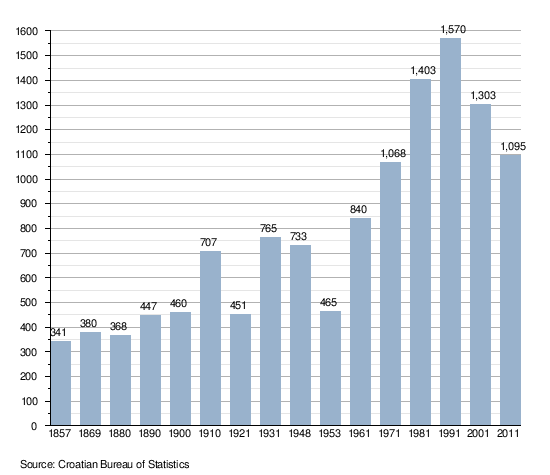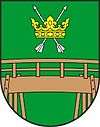Gvozd
| Gvozd Гвозд/Вргинмост (Serbian)[1] | ||
|---|---|---|
| Municipality and Settlement | ||
| Općina Gvozd/Naselje Vrginmost | ||
.jpg) | ||
| ||
|
Map of the municipality within Sisak-Moslavina County | ||
 Vrginmost Location in Croatia | ||
| Coordinates: 45°20′56″N 15°51′55″E / 45.34889°N 15.86528°E | ||
| Country |
| |
| Region | Continental Croatia | |
| County |
| |
| Municipality | Gvozd | |
| Government | ||
| • Municipal mayor | Milan Vrga (SDSS) | |
| Area | ||
| • Total | 212.4 km2 (82.0 sq mi) | |
| Elevation | 131 m (430 ft) | |
| Population (2011)[2] | ||
| • Total | 2,970 | |
| Time zone | UTC+1 (CET) | |
| • Summer (DST) | UTC+2 (CEST) | |
| Postal code | (+385) 44 | |
| Area code(s) | (+385)044 | |
Gvozd (Serbian Cyrillic: Гвозд/Вргинмост)[1] is a municipality in central Croatia, Sisak-Moslavina County.[2] Its seat is located in Vrginmost (Vrgin Most), which was renamed to Gvozd from 1996–2012.[3] In 2012, its original name of Vrginmost was restored amid political controversy.[4][5][6] It is underdeveloped municipality which is statistically classified as the First Category Area of Special State Concern by the Government of Croatia.[7]
Languages and names
Croatian is the official first language. Serbian language with its Cyrillic alphabet is the officially recognised second language. In Cyrillic, Vrginmost is known as Вргинмост and (between 1996 and 2012) Gvozd as Гвозд.
History
In 1097, the last native Croatian King Petar Svačić was killed here during the Battle of Gvozd Mountain, which led to the mountain being renamed Petrova Gora (Petar's Mountain). It was ruled by Ottoman Empire between 1536 and 1691 as part of Bosnia Eyalet.
In the summer of 1941, the villages of then District of Vrginmost suffered heavy loss of civilian life with several hundred ethnic Serb men and boys perishing in the Glina massacre on 3 August 1941. Majority of the victims of the August massacre in Glina were from the villages of Blatuša, Podgorje, Crevarska Strana, Slavsko Polje, Brnjavac, Pješčanica, Gornja Čemernica, Donja Čemernica, Bukovica and Batinova Kosa.[8]
The Ostrožin Rulebook (Croatian: Ostrožinski pravilnik) was adopted on 14 December 1941 in the village of Ostrožin.[9] Predating the Foča Regulations by more than a month, the Ostrožin Rulebook was the first legal act which regulated the new national authority in the liberated territories during the National Liberation War of Yugoslavia.
In 1942, Andrija Artuković ordered the killing of the entire population of Vrginmost and its surrounding villages in 1942, according to the charges laid against him in his deportation hearings in the United States.[10]
The town was officially known as Gvozd between 1996[11] and 23 October 2012.
During the Croatian War of Independence, Vrginmost was a part of the unrecognized breakaway Republic of Serbian Krajina. It was retaken by the Croatian army during Operation Storm.
Demographics
Settlements
The municipality consists of 19 settlements:[2]
- Blatuša, population 171
- Bović, population 91
- Brnjavac, population 93
- Crevarska Strana, population 161
- Čremušnica, population 103
- Dugo Selo Lasinjsko, population 46
- Golinja, population 38
- Gornja Čemernica, population 142
- Gornja Trstenica, population 88
- Kirin, population 52
- Kozarac, population 122
- Ostrožin, population 32
- Pješčanica, population 161
- Podgorje, population 150
- Slavsko Polje, population 338
- Stipan, population 50
- Šljivovac, population 32
- Trepča, population 5
- Vrginmost (Gvozd at the time of census), population 1,095
Population of Gvozd municipality by ethnicity[2][12]
| Year of census | total | Serbs | Croats | Yugoslavs | others |
|---|---|---|---|---|---|
| 2011 | 2 970 | 1 976 (66.53%) | 951 (32.02%) | - | 43 (1.45%) |
| 2001 | 3 779 | 2 193 (58.03%) | 1 500 (39.69%) | - | 86 (2.28%) |
| 1991 | 16 599 | 11 729 (70.66%) | 4 043 (24.36%) | 278 (1.68%) | 549 (3.31%) |
| 1981 | 18 841 | 13 450 (71.39%) | 4 130 (21.92%) | 871 (4.62%) | 390 (2.07%) |
| 1971 | 21 536 | 16 337 (75.86%) | 4 866 (22.60%) | 184 (0.85%) | 149 (0.69%) |
- NOTE: Historically, the municipality was known as Vrginmost until 1996, when both the municipality and the settlement were renamed to Gvozd. The old municipality of Vrginmost was divided into three new municipalities: Topusko, Lasinja and Gvozd.
Population of Vrginmost settlement by ethnicity[2][13]
| Year of census | total | Serbs | Croats | Yugoslavs | others |
|---|---|---|---|---|---|
| 2011 | 1 095 | 322 (29.41%) | 755 (68.95%) | - | 18 (1.64%) |
| 2001 | 1 303 | n/a | n/a | - | n/a |
| 1991 | 1 570 | 1 403 (89.36%) | 47 (2.99%) | 42 (2.68%) | 78 (4.97%) |
| 1981 | 1 403 | 1 185 (84.46%) | 44 (3.14%) | 125 (8.91%) | 49 (3.49%) |
| 1971 | 1 068 | 929 (86.99%) | 65 (6.09%) | 34 (3.18%) | 40 (3.74%) |
- NOTE: The settlement is historically known as Vrginmost. During the 1996-2012 period, the settlement was known as Gvozd
Historical population of Vrginmost settlement 1857-2011 [2][14]

History
The municipality had big population changes in various censuses, possibly because of war and because of frequent border changes of municipalities in Croatia:
Sights and events
- Monument to the Uprising of the People of Kordun and Banija
- Monument to the Antifascist Uprising and Victims of Fascism - a bronze partisan sculpture by sculptor Zvonko Car erected in 1956. According to the witness' statements,[16] the monument was destroyed and its remains removed from the site in Vrginmost around 26 November 1995. Fragments of the monument's decorative mosaic featuring partisans had been recovered from garbage disposal site.
- Abez Forest - site of the historical meeting, held on 19 July 1941, at which the leadership of the Croatian branch of the Communist Party of Yugoslavia decided that the people of the Kordun and Banija region raise against the nazi-fascist occupation[17]
- Site of formation of the partisan 8th Kordun Division (Croatian: 8. Kordunaška udarna divizija NOVJ) on 22 November 1942 in Crevarska Strana[18]8. кордунашка дивизија НОВЈ
- Đedova kosidba - cultural and historical, tourist manifestation held in Vrginmost, nurturing the folk customs and traditions of Kordun and traditional ways of life. The one-day event, which was first held in 2010, takes place between May and late June and brings together amateur groups nurturing traditional folk dancing and singing from different regions of Croatia and north-west of Bosnia and Herzegovina.[19][20][21]
Notable natives and residents
- Ognjeslav Utješinović Ostrožinski (1817–1890) - politician and writer
- Gavrilo von Rodić (1812–1890) - general and high ranking state official in the Habsburg Monarchy
- Stephan von Ljubičić (1855–1935) - general in Austro-Hungarian army and decorated military commander
- Rade Bulat (1920–2013) - Yugoslav communist, antifascist, partisan general, electrical engineer and People's Hero of Yugoslavia
- Branko Mamula (born 1921) - antifascist and partisan fighter, admiral of the JNA, Minister of Defence of Yugoslavia from 1982 to 1988
- Mile Mrkšić (1947–2015) - JNA colonel, convicted by the ICTY of failing to prevent war crimes against POWs during the 1991-1995 war in Croatia
- Pavle Jakšić (1913–2005) - physicist, antifascist, partisan general, Chief of Staff of the 4th Yugoslav Army and People's Hero of Yugoslavia
- Gojko Nikoliš (1911–1995) - medical doctor, historian, volunteer in International Brigades in Spanish Civil War, partisan general, the first Head of the Partisan Medical Corps, member of SANU and People's Hero of Yugoslavia
- Ankica Barbir-Mladinović (born 1949) - journalist, TV Zagreb/HTV news editor and the youngest editor of "Zagrebačka panorama"[22]
- ITD Band - the first members of the Croatian/Yugoslav pop rock band were Vrginmost natives and residents: Branislav Bekić (vocals), Milan Bekić (bass guitar) and Nebojša Tepšić (drums). Rastislav Topoljski (keyboards), who joined the band later on, was another Vrginmost resident, while Jadranko Mileusnić (guitar) was a native of Vojnić.[23][24][25][26]
- Aleksandar Raković (born 1968) - race walker and Olympian athlete[27]
See also
References
- 1 2 Government of Croatia (October 2013). "Peto izvješće Republike Hrvatske o primjeni Europske povelje o regionalnim ili manjinskim jezicima" (PDF) (in Croatian). Council of Europe. p. 36. Retrieved 30 November 2016.
- 1 2 3 4 5 6 "Population by Age and Sex, by Settlements, 2011 Census: Gvozd". Census of Population, Households and Dwellings 2011. Zagreb: Croatian Bureau of Statistics. December 2012.
- ↑ "Brisanje imena gradova: Gvozd ili Vrginmost". slobodnaevropa.org (in Croatian). 15 August 2011.
- ↑ "Promijenili ime Gvozda u - Vrginmost" (in Croatian). Nova TV (Croatia). Retrieved 20 April 2013.
- ↑ "Pokrajine". Novossti.com. 29 October 2012. Retrieved 30 January 2016.
- ↑ "Gvozd će se opet zvati Vrginmost". Dnevnik.hr. 13 June 2012. Retrieved 30 January 2016.
- ↑ Lovrinčević, Željko; Davor, Mikulić; Budak, Jelena (June 2004). "AREAS OF SPECIAL STATE CONCERN IN CROATIA- REGIONAL DEVELOPMENT DIFFERENCES AND THE DEMOGRAPHIC AND EDUCATIONAL CHARACTERISTICS". Ekonomski pregled, Vol.55 No.5-6. Retrieved 25 August 2018.
- ↑ Dušan Baić "Kotar Vrginmost u NO borbi 1941-1945."/"District of Vrginmost during National Liberation War 1941-1945", pages 55-60, 1980
- ↑ Branko Žutić, “Razvitak narodne vlasti u kotaru Vrginmost 1941-1943”, Historijski zbornik, pg 81, Naklada Školska knjiga, Zagreb, 1955.
- ↑ ROHRLICH, TED (19 January 1988). "Artukovic, Extradited as Nazi War Criminal, Dies" – via LA Times.
- ↑ "Croatian mayor sees U.S. holiday first-hand Visitor from war-torn nation enjoys feast and festivities", Daily Herald, 29 November 2002.
- ↑ Izdanje Državnog zavoda za statistiku RH: Narodnosni sastav stanovništva RH od 1880-1991. godine.
- ↑ Izdanje Državnog zavoda za statistiku RH: Narodnosni sastav stanovništva RH od 1880-1991. godine.
- ↑ Naselja i stanovništvo Republike Hrvatske 1857-2001, www.dzs.hr
- 1 2 "SAS Output". Dzs.hr. Retrieved 30 January 2016.
- ↑ "Reljef s partizanima spašen iz smeća". portalnovosti.com (in Serbian). 31 October 2014. Retrieved 1 September 2018.
- ↑ Dušan Baić "Kotar Vrginmost u NO borbi 1941-1945."/"District of Vrginmost during National Liberation War 1941-1945", pages 44-45, 1980
- ↑ "75 godina Osme kordunaške/ "75 years of the 8th Kordun (partisan) Division"". portalnovosti.com (in Croatian). 27 September 2017. Retrieved 17 March 2018.
- ↑ "Đedova kosidba 2014". Online Televizija Glina (in Croatian). 16 August 2014. Retrieved 1 September 2018.
- ↑ "Đedova kosidba 2017". Radio Banovina (in Croatian). 16 July 2017. Retrieved 1 September 2018.
- ↑ "Održana deveta Đedova kosidba u Vrginmostu 2018". Banija Online (in Serbian). 1 July 2018. Retrieved 1 September 2018.
- ↑ "Barbir-Mladinović, Ankica". hrt.hr (in Croatian). Retrieved 14 February 2018.
- ↑ "ITD band - "Sonja"". ITD Band (in Croatian). 2006. Retrieved 11 March 2018.
- ↑ "ITD band - "Skidam te pogledom"". ITD Band (in Croatian). 2006. Retrieved 31 March 2018.
- ↑ "ITD band - "Lagano umirem"". ITD Band,tvtrogir.hr (in Croatian). 2006. Retrieved 31 March 2018.
- ↑ "ITD band - "Gradske cure"". ITD Band (in Croatian). 2006. Retrieved 31 March 2018.
- ↑ "Interview with Ljubomir Raković, Vrginmost"" (in Croatian). 2015. Retrieved 21 July 2018.
External links
| Wikimedia Commons has media related to Gvozd municipality. |
Coordinates: 45°20′56″N 15°51′55″E / 45.34889°N 15.86528°E
